ICESat-2 Mission Overview#
The Ice Cloud, and land Elevation Satellite-2 (ICESat-2) mission is NASA’s current polar-orbiting laser altimeter. Here, we present an overview of the ICESat-2 mission, mission instrumentation, and current ICESat-2 products.
ICESat-2 Products: from
photons
to gridsTyler C. Sutterley*
Polar Science Center
Applied Physics Laboratory
tsutterl@uw.edu
∗with help and materials from ICESat-2 PSO, Science Team and collaborators
Part 1
Mission and Instrument Overview
ICESat-2 Science Objectives
- Quantify polar ice sheet contributions to current and recent sea level change and the linkages to climate conditions
- Quantify regional signatures of ice sheet changes
- Assess mechanisms driving recent changes
- Improve predictive ice sheet models
- Estimate sea ice thickness to examine ice-ocean-atmosphere exchanges of energy, mass and moisture
- Measure vegetation canopy height as a basis for estimating large-scale biomass and biomass change
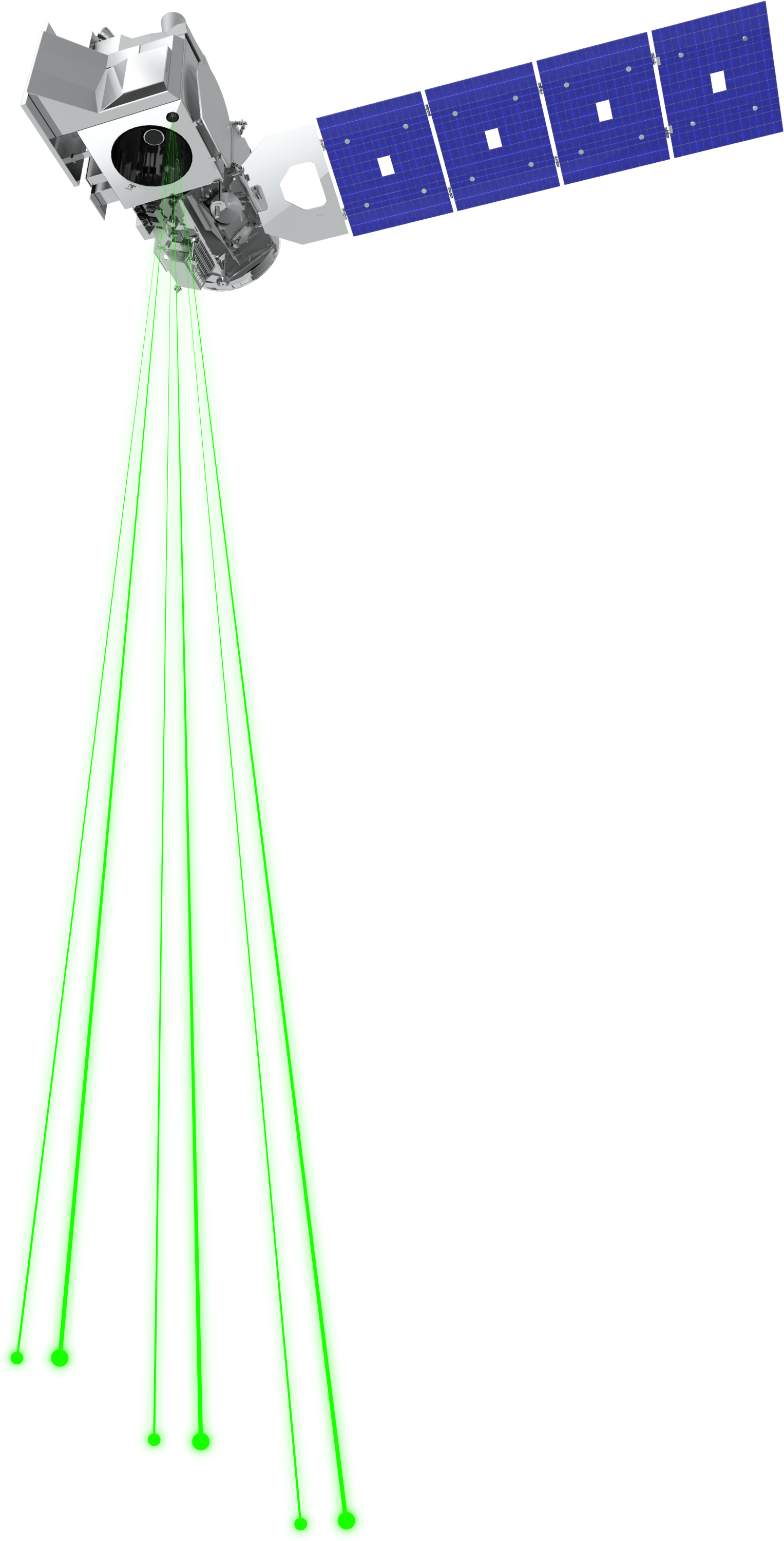
Advanced Topographic Laser Altimeter System (ATLAS)
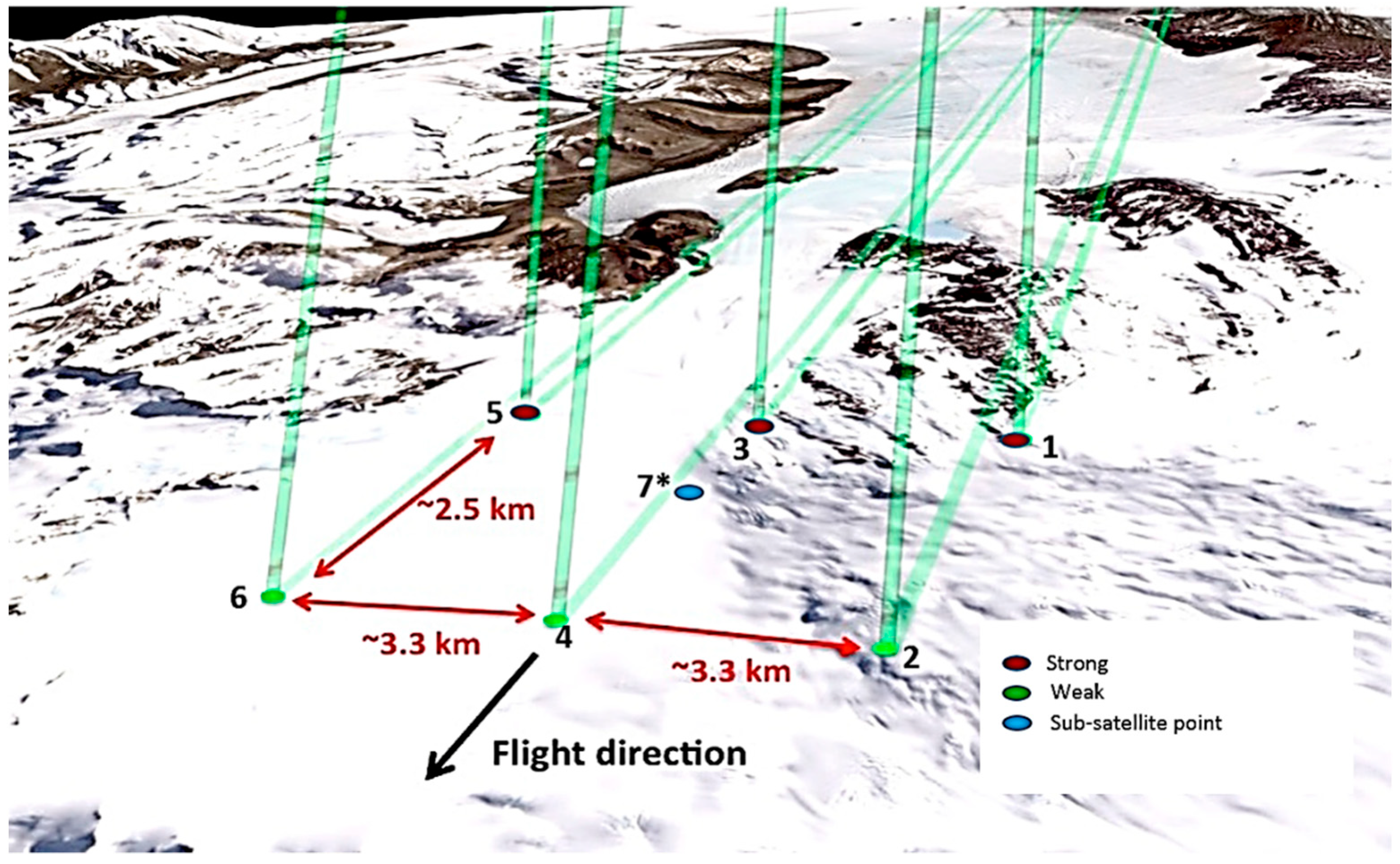
- Single 10kHz 532nm laser micro-pulse → split into 6 beams
- Detectors sensitive to green light returns at the single photon level
- On-the-ground 3 km spacing between pairs to increase spatial coverage
- On-the-ground 90 m pair spacing for slope determination
- Different beam energies to provide dynamic range for varying surface reflectances
- High-energy beams (4×) for better performance over low-reflectivity targets
Figure 2 from [Neuenschwander and Magruder, 2019]
ATLAS Transmitter

ATL03 Algorithm Theoretical Basis Document (ATBD)
ATLAS Receiver
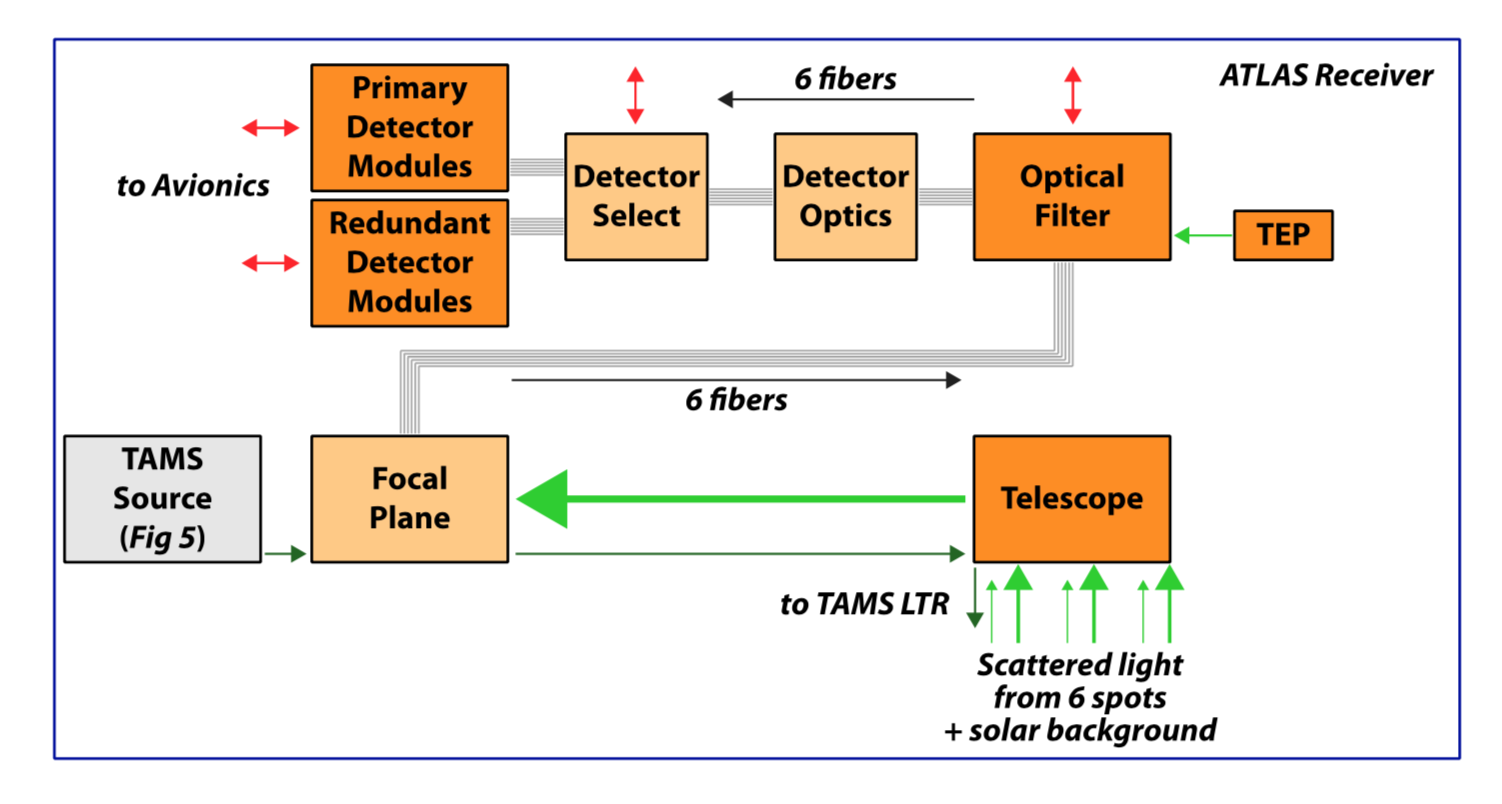
ATL03 Algorithm Theoretical Basis Document (ATBD)
ATLAS Photon Timing

ATL03 Algorithm Theoretical Basis Document (ATBD)
ICESat-2 Photon Geolocation
Position of observatory in space
- Precision Orbit Determination (POD) – NASA GSFC
- Based on Ruag GPS receivers
- Verified with Satellite Laser Ranging (SLR)
- Orbit known to < 2 cm radial
Pointing vectors for ATLAS laser beams
- Precision Pointing Determination (PPD) – UT Austin Applied Research Lab
- Based on Sodern Star Trackers and Laser Reference System (LRS)
- Verified with cal/val data comparisons with photon returns
Photon time of flight + POD + PPD → photon return bounce point
ICESat-2 Primary Measurements
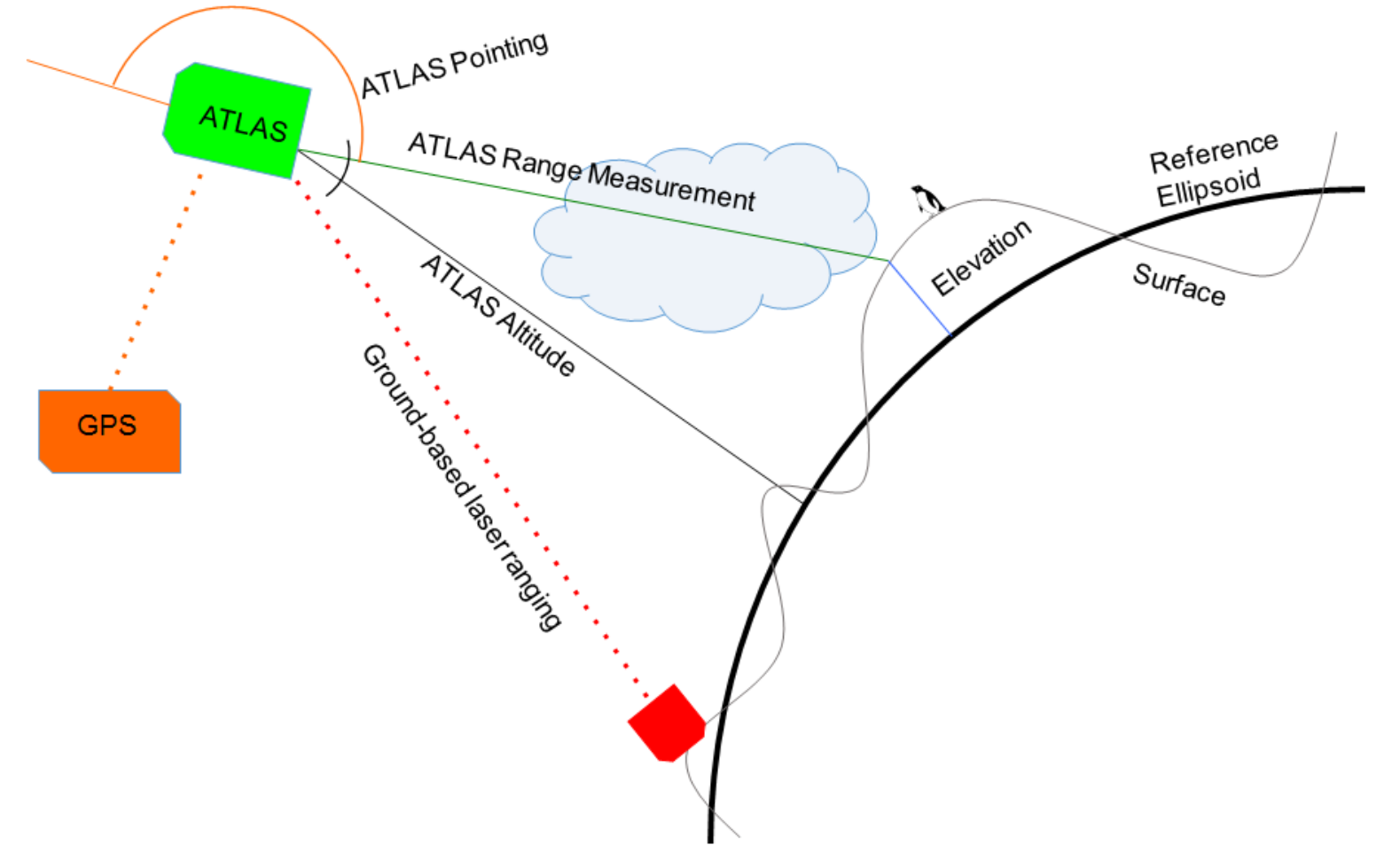
Figure 2 from the ATL02 Algorithm Theoretical Basis Document (ATBD)
ICESat-2 Orbits
- 500 km altitude
- 88° S to 88° N
- 15 revolutions/day
- 1387 repeat ground tracks
- 91-day revisit time
- Predicted ground tracks available at icesat-2.gsfc.nasa.gov
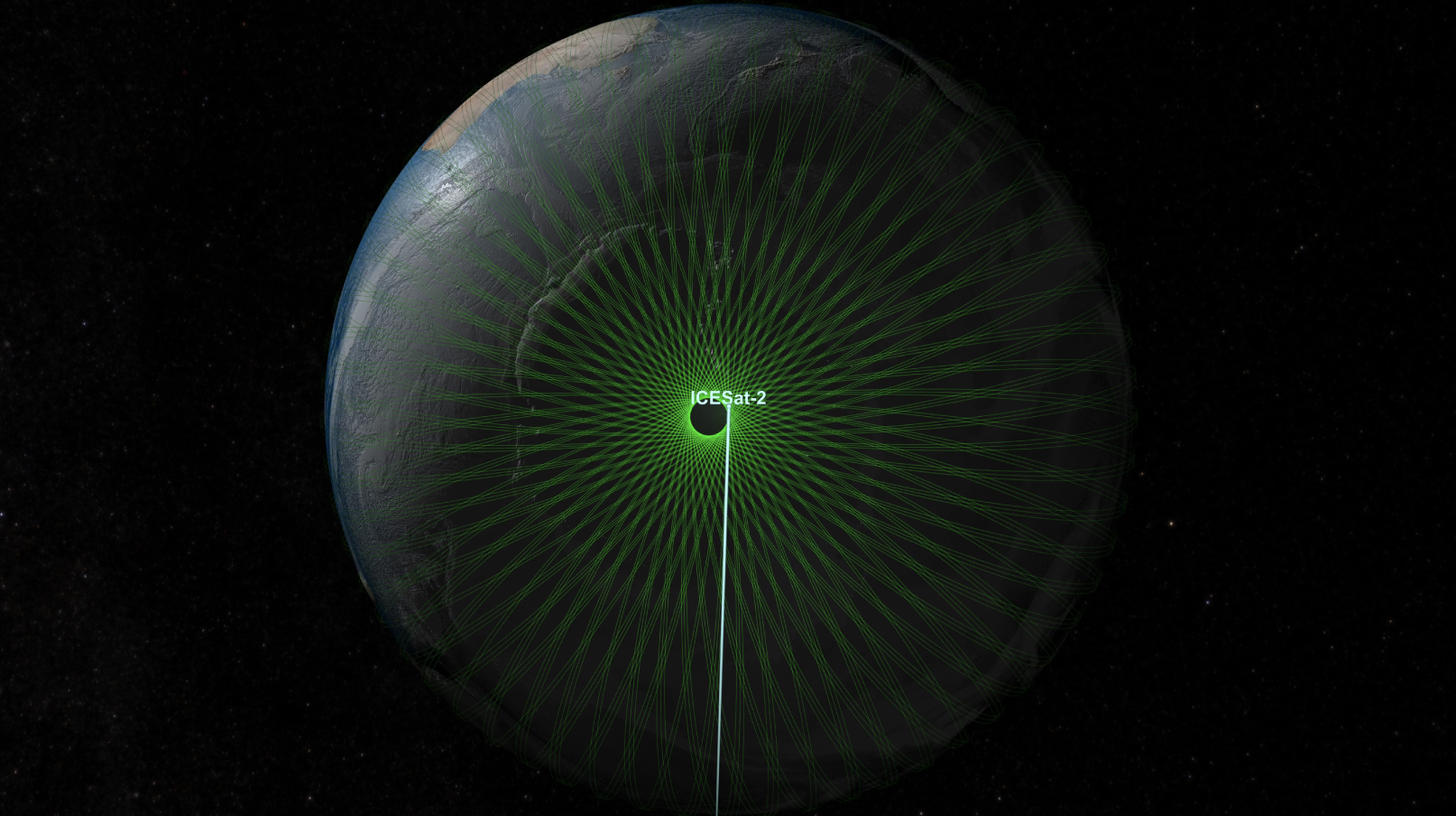
NASA Science Visualization Studio
ICESat-2 Along-Track Sampling
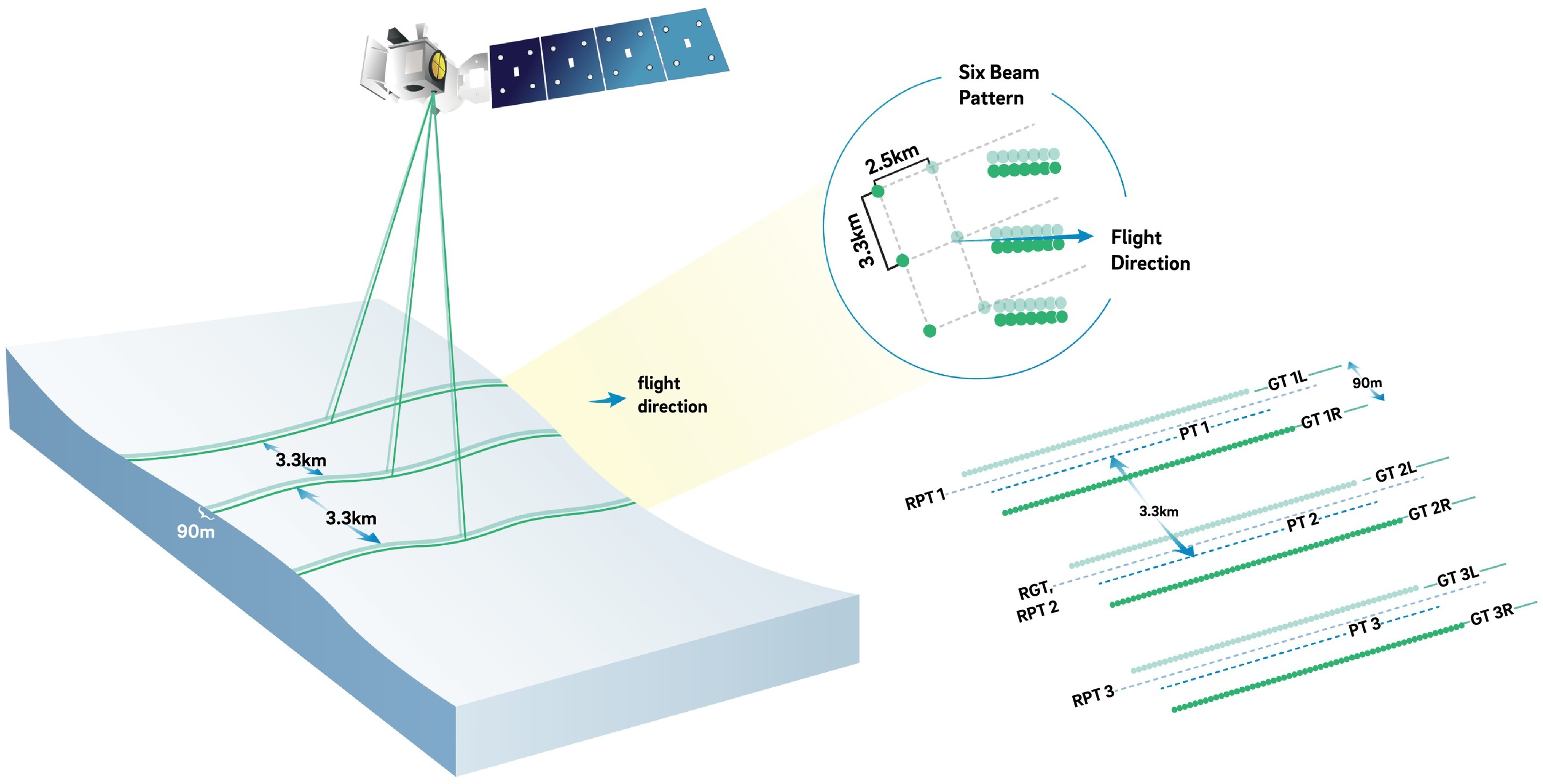
Figure 1 from [Smith et al., 2019]
Spacecraft Orientation
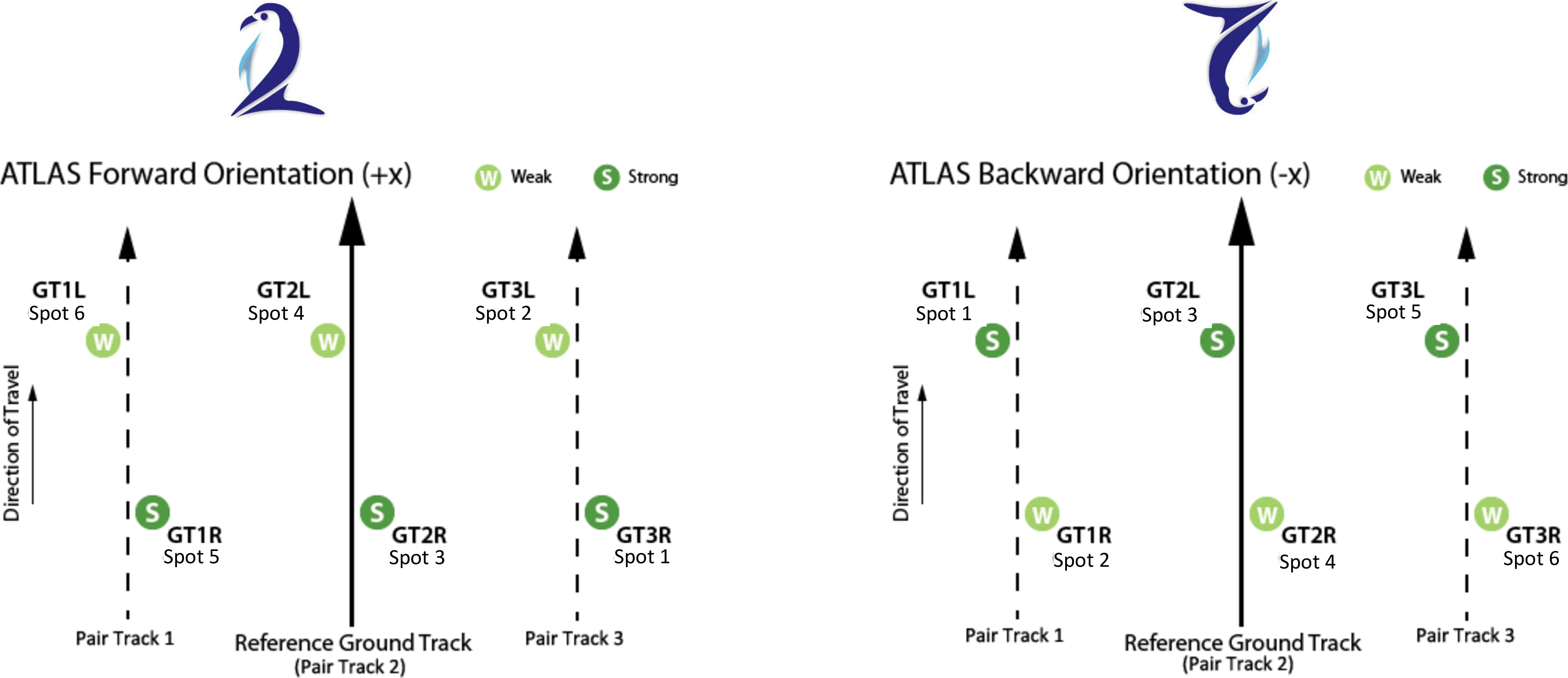
Provided by NSIDC
ICESat-2 Local Coordinate System
- Along-track coordinates,
x_atc
, are measured parallel to each RGT and are in reference to the equator - Across-track coordinates,
y_atc
, are measured perpendicular to and in reference to the RGT - Averaging Schemes:
- Measurements can be averaged over a set along-track distance
- Measurements can be averaged over a set number of photons and have a variable along-track length
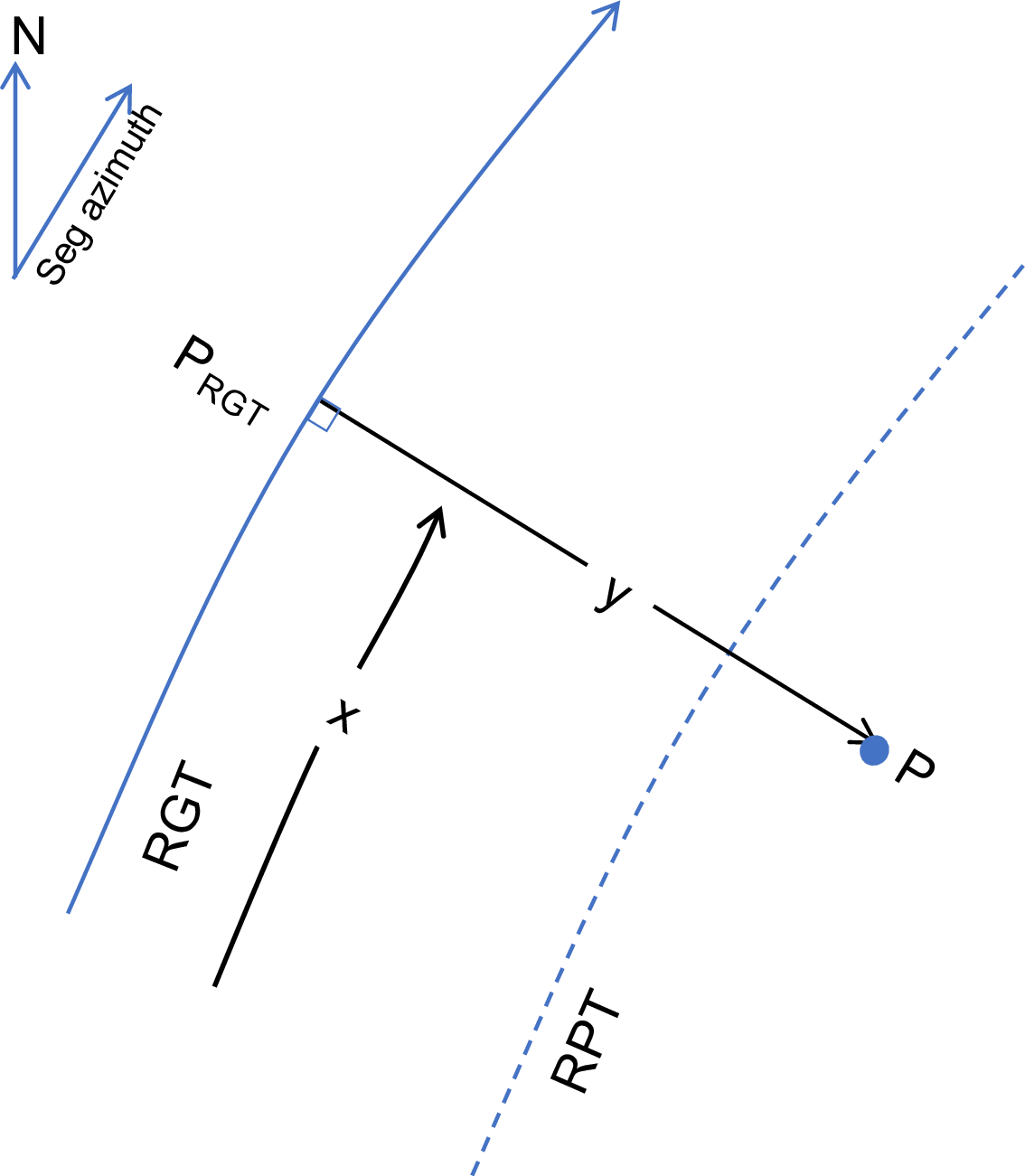
Figure 3.5 from the ATL06 Algorithm Theoretical Basis Document (ATBD)
Part 2
Data Products
ICESat-2 Data Production

- ATLAS: Advanced Topographic Laser Altimeter System
- ASAS: ATLAS Science Algorithm Software
- PGE: Product Generation Executive
- SIPS: Science Investigator-led Processing System
- SCF: Science Computing Facility
ICESat-2 Product Chart
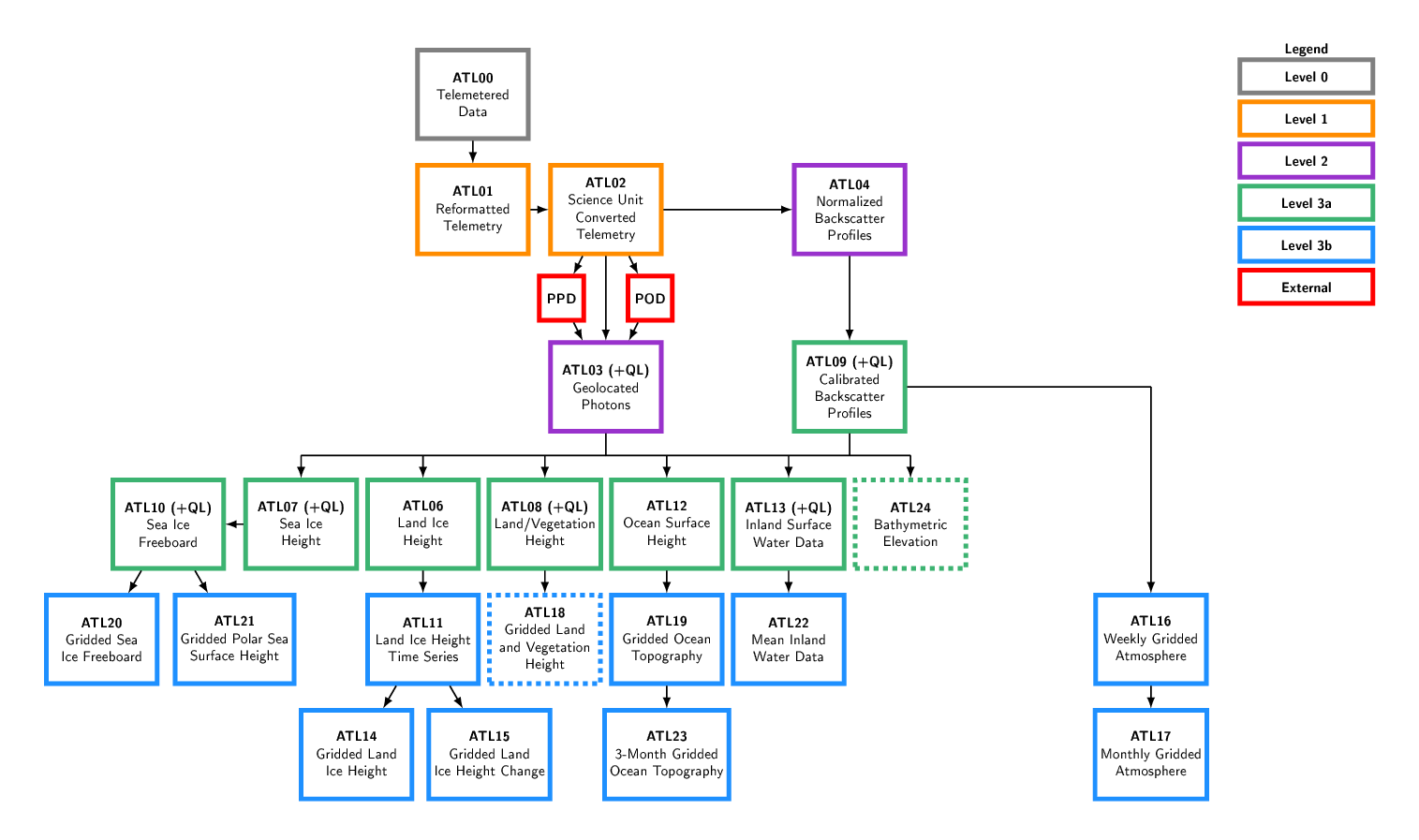
ANC: Ancillary Data, CAL: Calibration Product, POD: Precision Orbit Determination, PPD: Precision Pointing Determination; QL: Quicklook Available
ICESat-2 Product Applications Chart
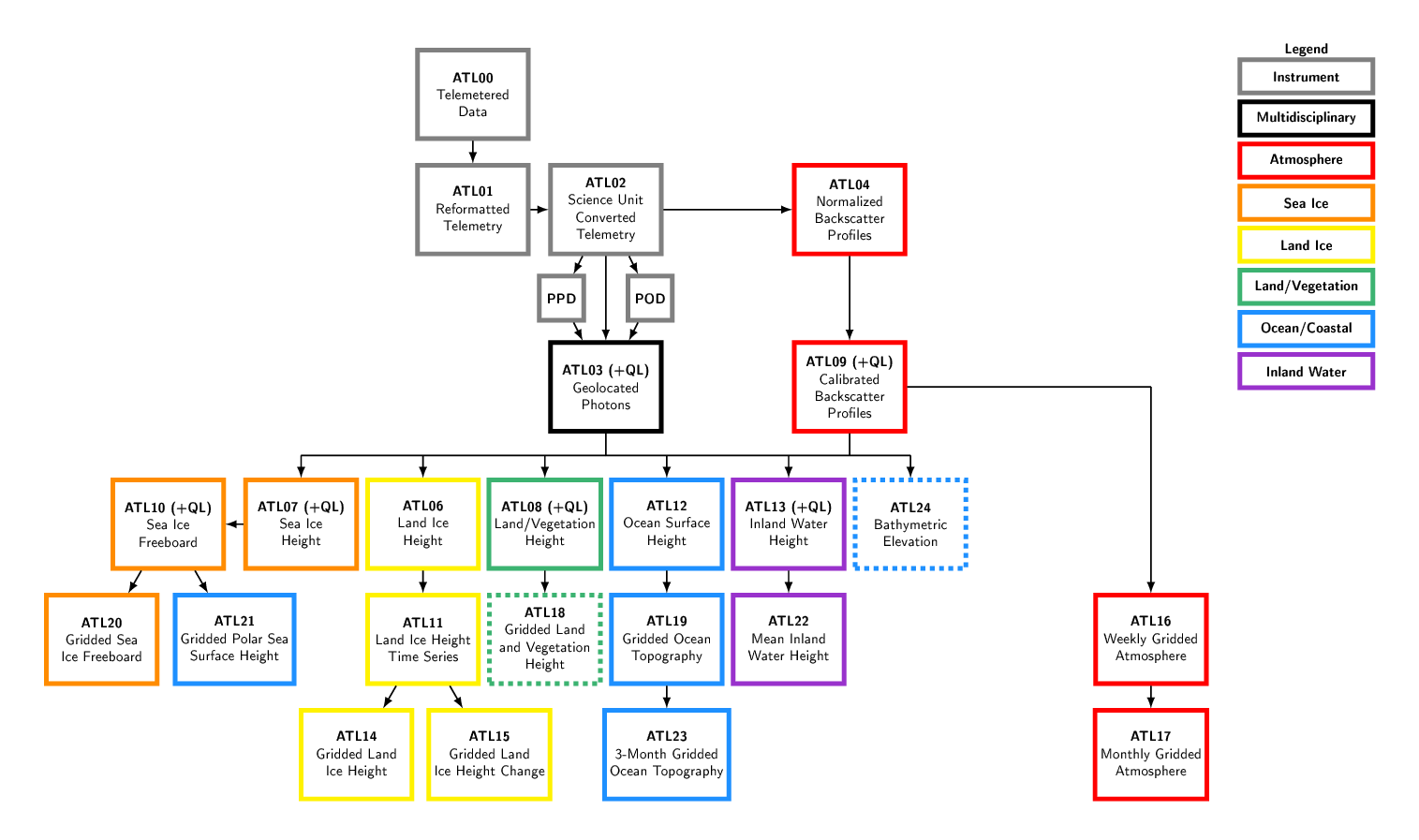
ANC: Ancillary Data, CAL: Calibration Product, POD: Precision Orbit Determination, PPD: Precision Pointing Determination; QL: Quicklook Available
Granule Regions
Each orbit of ICESat-2 data is broken up into 14 granules in order to limit the overall file sizes and to reduce the number of files that need to be processed to create the higher-level science products
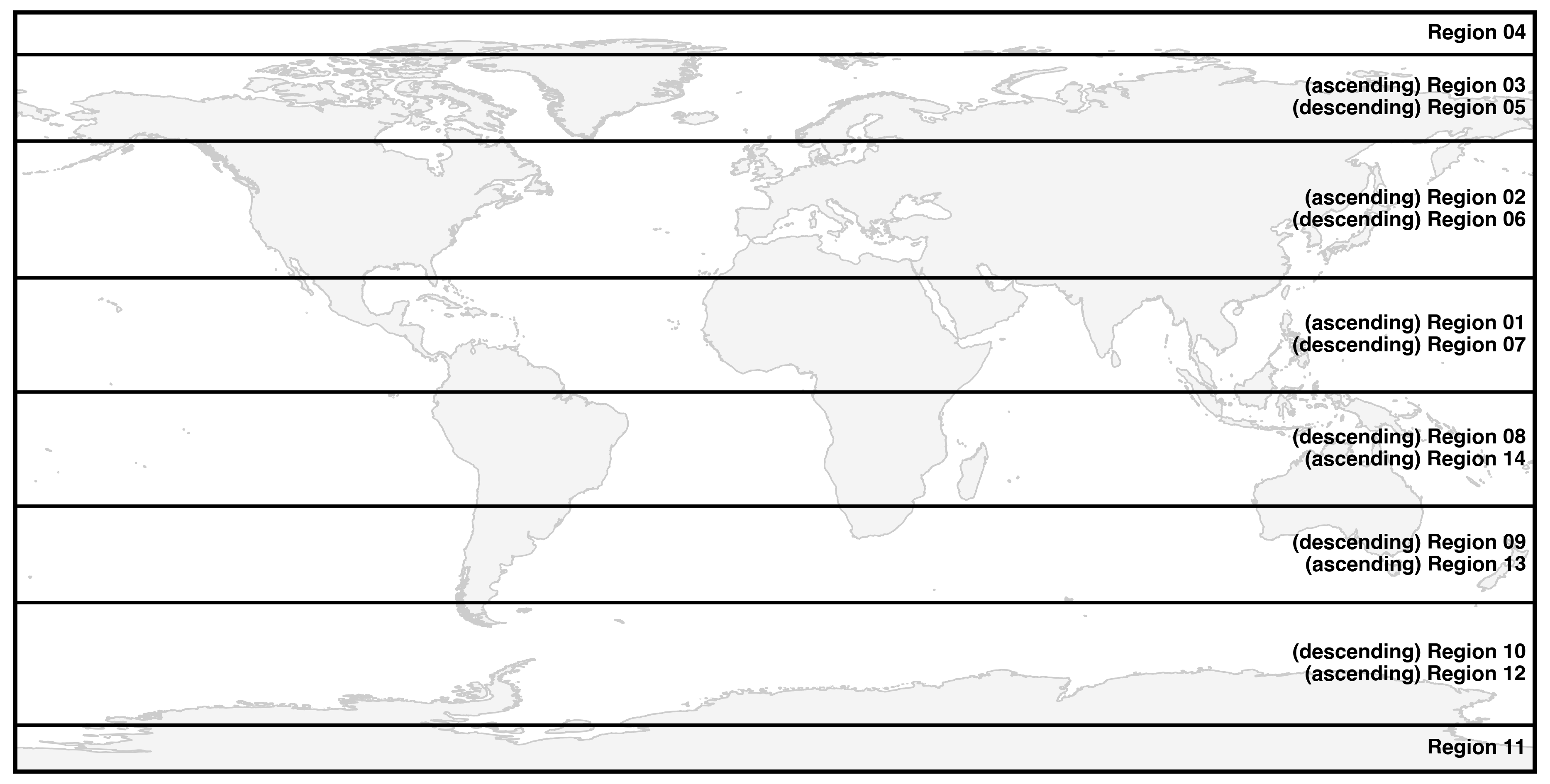
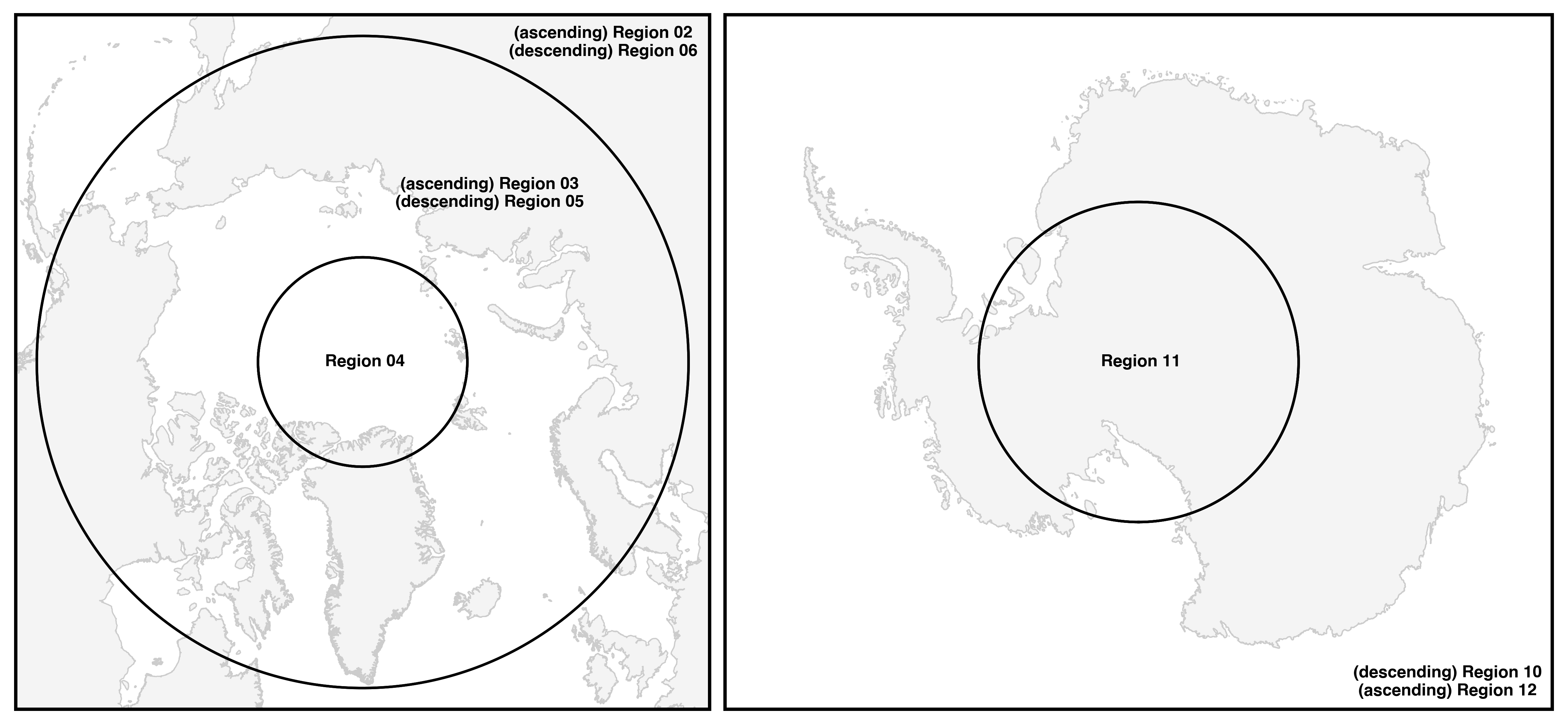
File Naming Conventions
ATL[xx]_[yyyymmdd][hhmmss]_[tttt][cc][nn]_[rrr]_[vv].h5
xx
: ATLAS product numberyyyymmdd
: year, month and day of data acquisitionhhmmss
: start time, hour, minute, and second of data acquisition (UTC)tttt
: Reference Ground Track (RGT, ranges from 1–1387)cc
: Orbital Cycle (91-day period)nn
: Granule number (ranges from 1–14, always 01 for atmosphere products)rrr
: Data release numbervv
: Data version number
used for ATL03, ATL04, ATL06, ATL08, ATL09, ATL10, ATL12, ATL13, ATL16, ATL17, ATL19, and ATL22
File Naming Conventions: Sea Ice
ATL[xx]-[hh]_[yyyymmdd][hhmmss]_[tttt][cc][nn]_[rrr]_[vv].h5
xx
: ATLAS product numberhh
: Sea ice hemisphere flag (01=north, 02=south)yyyymmdd
: year, month and day of data acquisitionhhmmss
: start time, hour, minute, and second of data acquisition (UTC)tttt
: Reference Ground Track (RGT, ranges from 1–1387)cc
: Orbital Cycle (91-day period)nn
: Granule number (always 01 for sea ice products)rrr
: Data release numbervv
: Data version number
used for ATL07, ATL10, ATL20, and ATL21
ATL03: Global Geolocated Photon Data
Contains:
- Geolocation, time and elevation for all photons telemetered from ATLAS
- Photon classifications for each surface type
- Geophysical and atmospheric corrections
- Instrumental parameters
Advantages:
- Every photon is there, and every parameter
- Can derive information for all surface types
Disadvantages:
- Large and complex product
- Might require applying instrumental corrections
Use if you want to:
- Look at surfaces at a scale unresolved in higher-level products
- Look at processes the higher-level products were not designed to observe
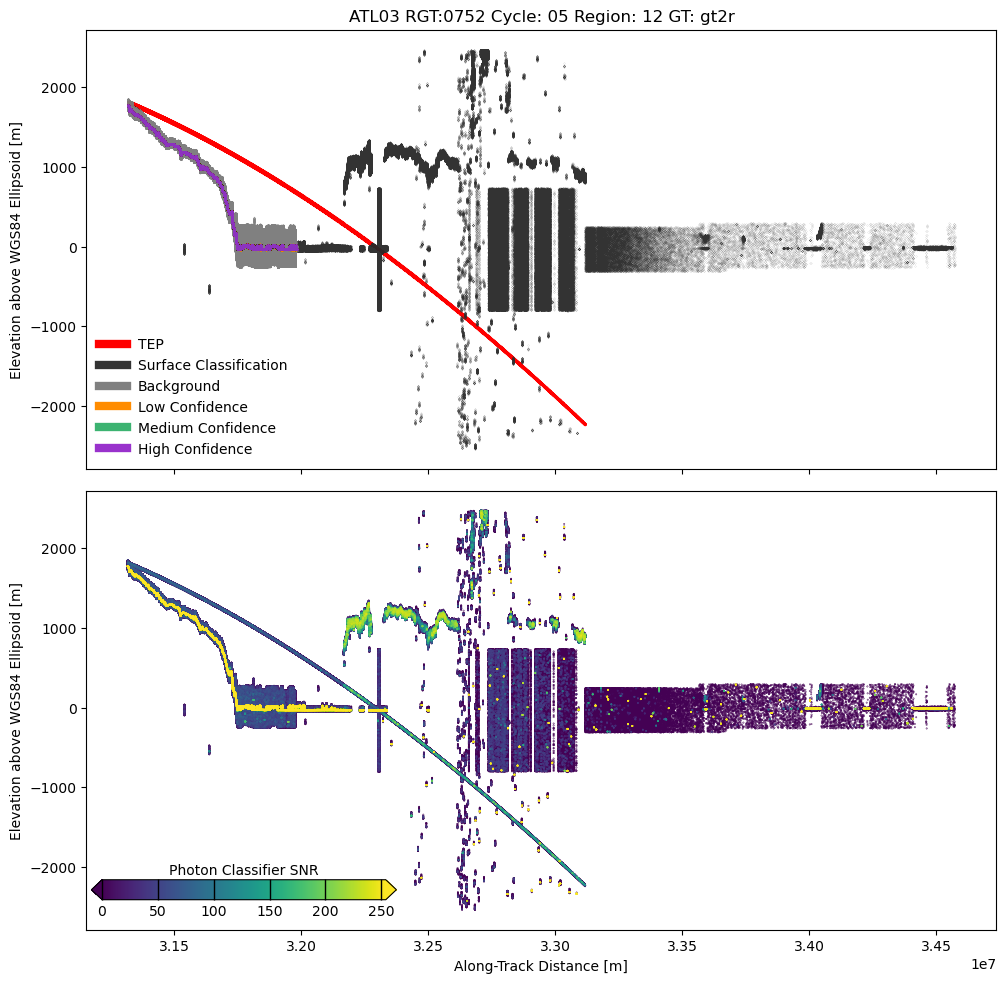
ATL04 and ATL09: Atmospheric Backscatter Profiles
Contains:
- Atmospheric layer heights and optical properties
Advantages:
- Much larger height window provided from the atmospheric data channel
Disadvantages:
- Relatively large file sizes
Use if you want to:
- Want to investigate cloud or suspended particle optical depths
- Visualize cloud returns or Antarctic blowing snow
- Want to try to understand atmospheric effects on photon ground returns

Figure 11 from [Palm et al., 2021]
ATL06: Land Ice Height Data
Contains:
- Overlapping 40-meter linear segments fit to land and land-ice photons
- Height error and segment quality estimates
Advantages:
- Lighter product than ATL03
- Provides estimated surface heights with cm-level corrections
Disadvantages:
- 40 meters is too coarse for some applications
- Only designed for single surface returns
Use if you want to:
- Make large-scale repeatable measurements of glaciers and ice sheets

Figure 3 from [Smith et al., 2019]
ATL11: Slope-Corrected Land Ice Height Time Series
Contains:
- 120-meter along-track segments for each beam pair corrected for across-track slope
- Crossover estimates from ATL06 at reference points
Advantages:
- Contains data for all cycles with along-track data following the Reference Ground Tracks (RGTs)
- Easy calculation of height change through time
Disadvantages:
- 120-m resolution is too coarse for some applications
- May not work well over complex surfaces
Use if you want to:
- Make large-scale estimates of glacier and ice sheet height change
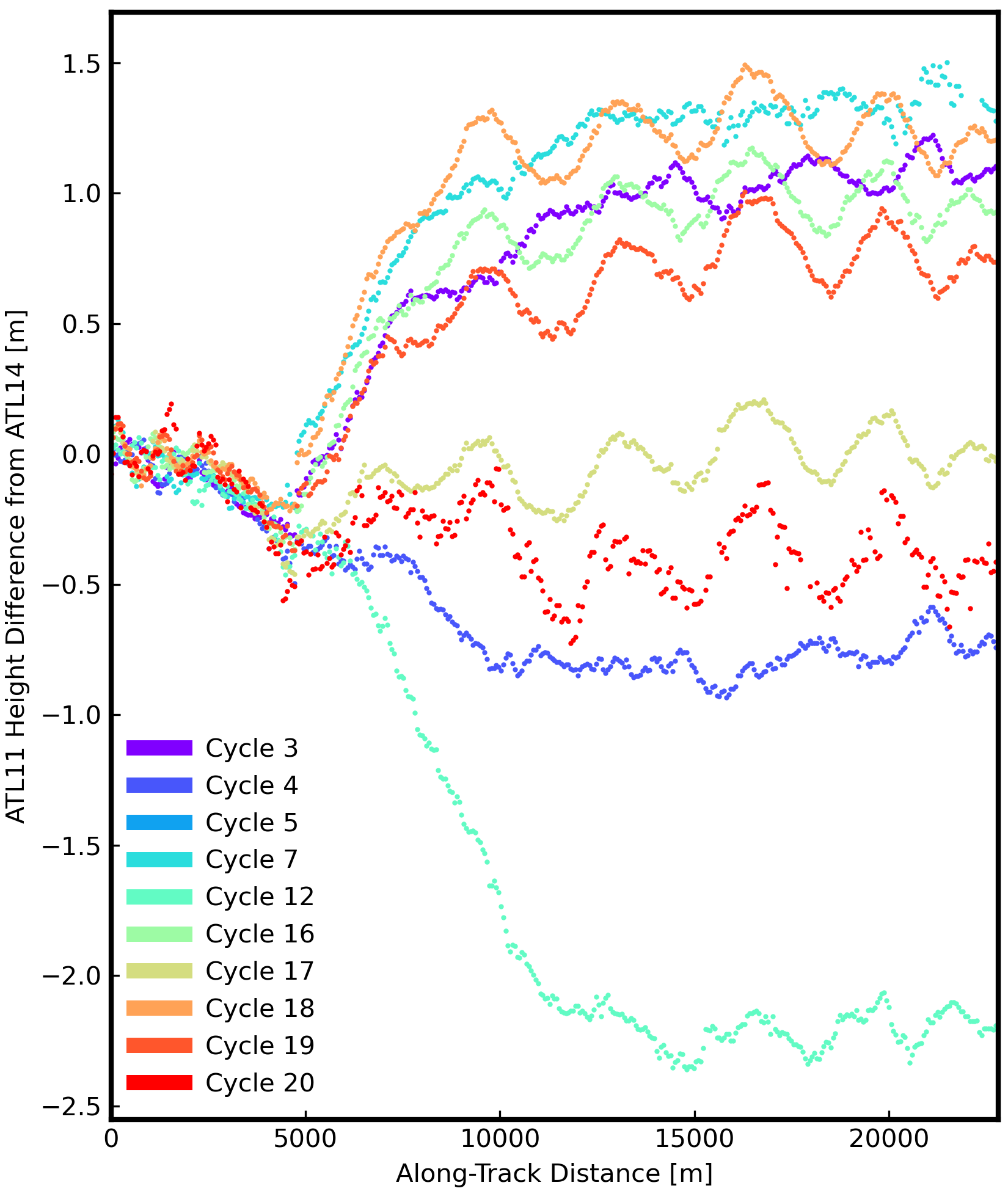
ATL14 and ATL15: Gridded Land Ice Height and Height Change
Contains:
- ATL14: gridded digital elevation model (DEM) and height uncertainty at 100m posting
- ATL15: gridded land ice height change estimates at 1km, 10km, 20km, and 40km posting
Advantages:
- Gridded product combining all available along-track ATL11 data
- Simplifies volume change calculations using ICESat-2 data
Disadvantages:
- ATL14 estimates degrade where measurements are unavailable
- Quarter-annual temporal sampling might not be high enough for certain applications
Use if you want to:
- Use gridded estimates of height change for ice sheet models
- Start creating land ice mass balance estimates from ICESat-2
- Extract land ice height change estimates along transects
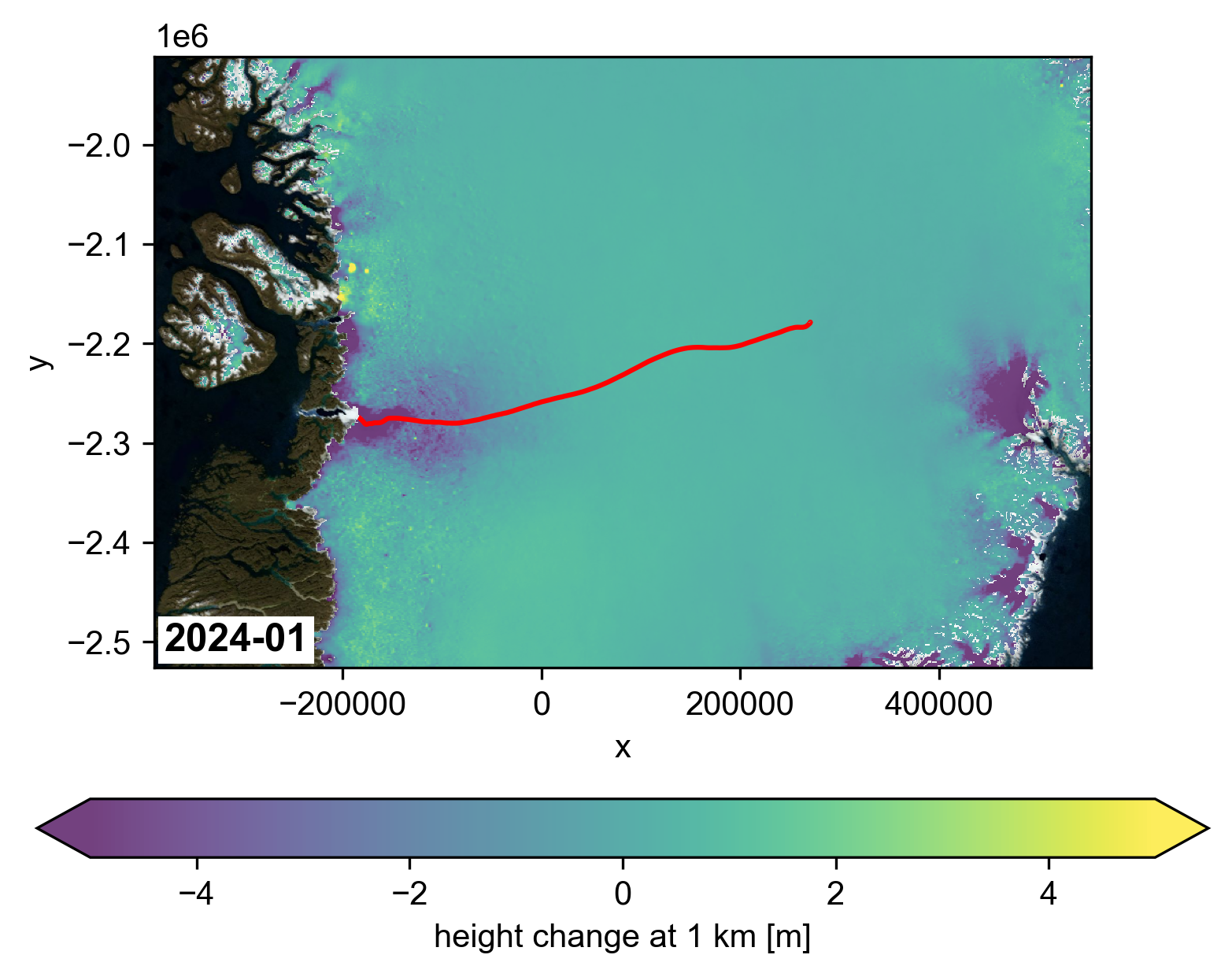
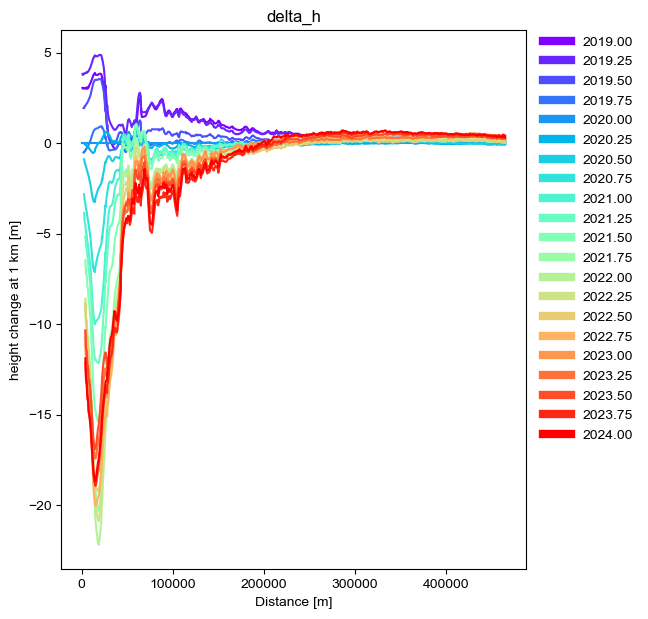
Transect of glacier flowlines from [Felikson et al., 2021]
ATL07: Sea Ice Height Data
Contains:
- Along-track heights for sea ice and leads
Advantages:
- High precision (~2 cm) height retrievals from 150-photon aggregates
- Classifications for varying surface types (e.g. open water leads, sea ice)
- Provides auxiliary information such as surface roughness and retrieval quality flags
Disadvantages:
- Surface retrievals have varying length scales
- Surface type flagging is still in development
Use if you want to:
- Have base level surface heights for freeboard or surface process studies
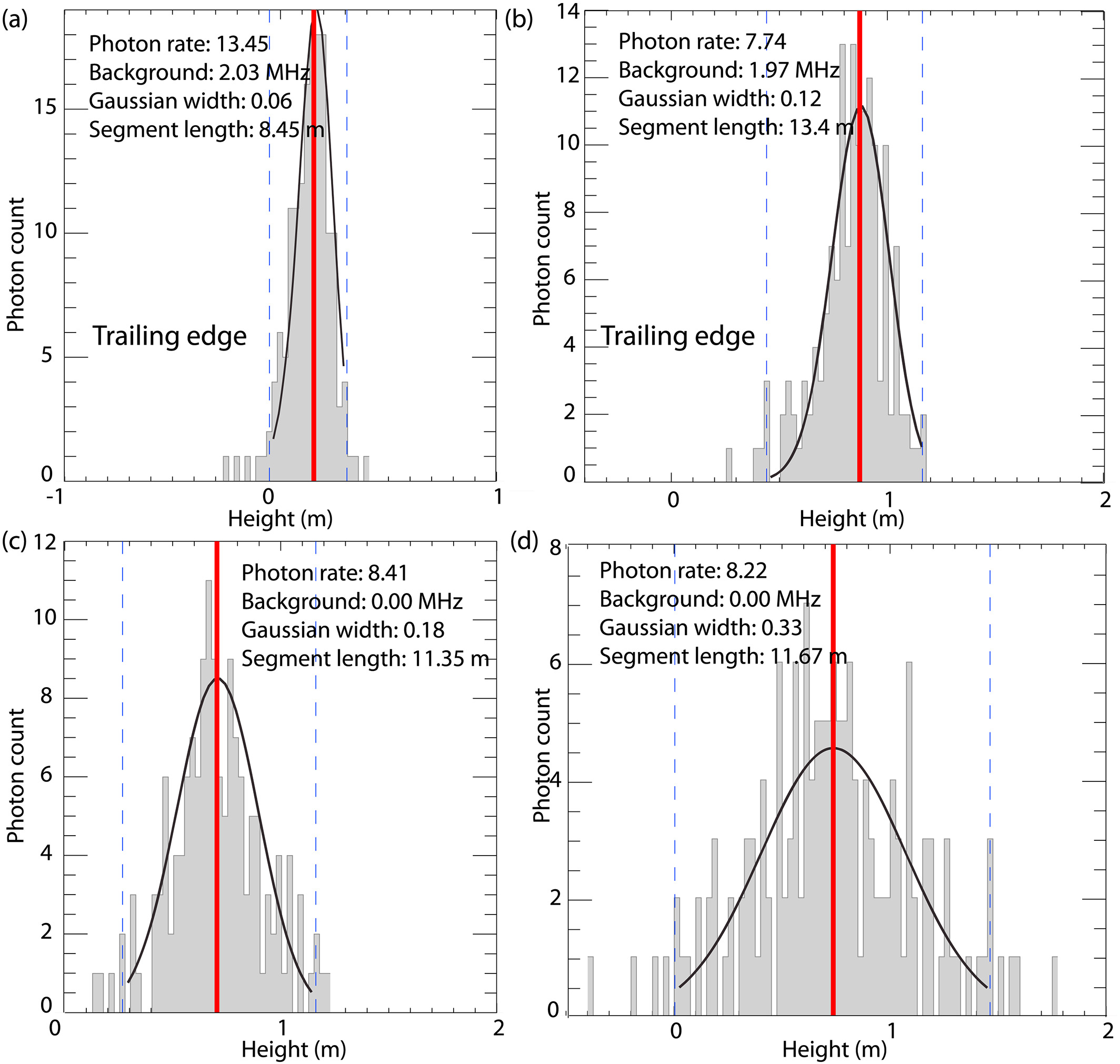
Figure 2 from [Kwok et al., 2019]
ATL10: Sea Ice Freeboard Data
Contains:
- Along-track sea ice freeboard and surface heights
- Surface type flagging and ancillary information
Advantages:
- Lighter product than ATL07 with higher level freeboard and surface types
Disadvantages:
- Higher levels of missing/invalid data than ATL07 (low ice concentration, near-coastal)
- Varying length scales of retrievals
- Summer sea ice retrievals still under investigation (July 2022 field campaign)
Use if you want to:
- Use along-track freeboard retrievals
- Use a highly accurate product (3 cm or better over 25 km length scales)
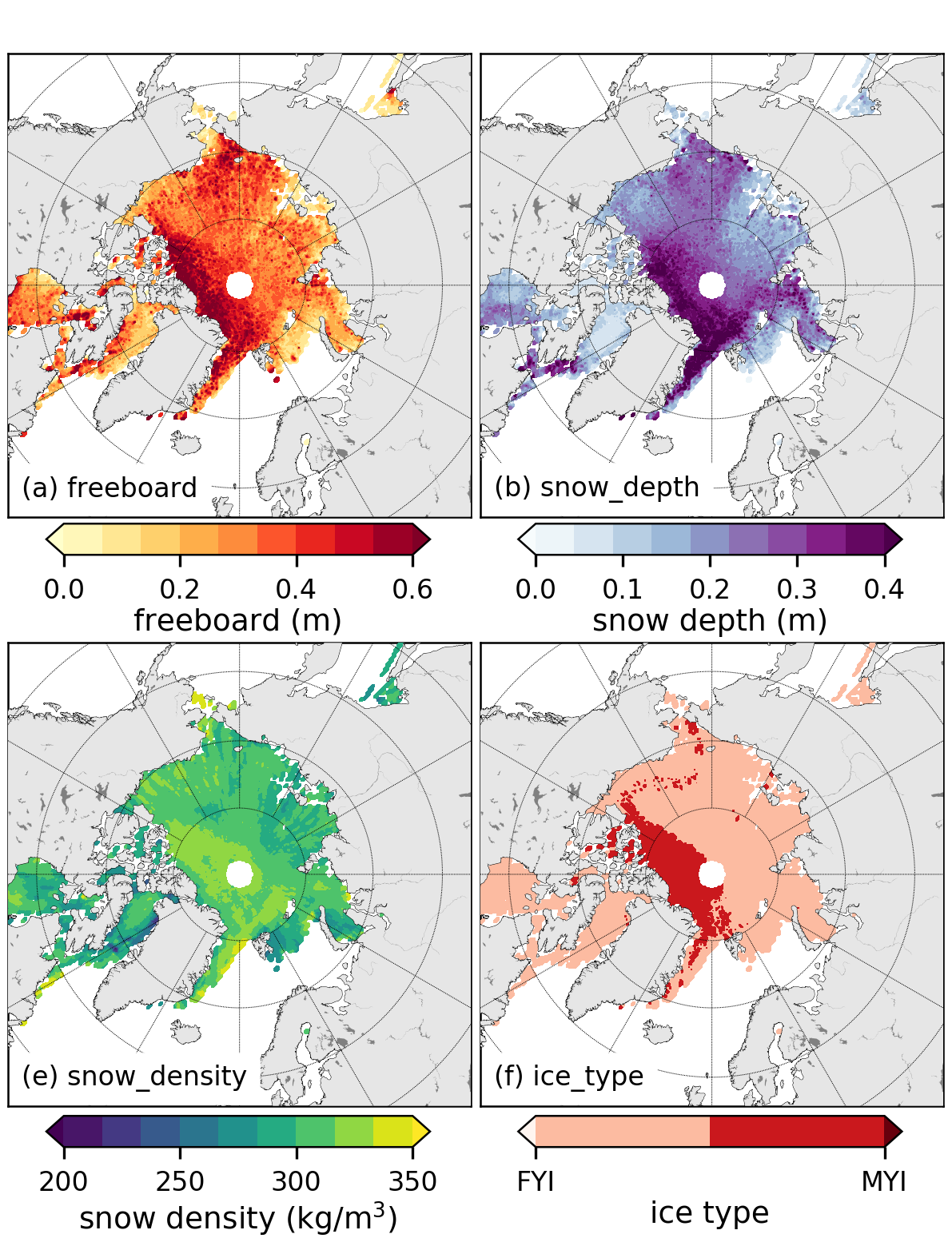
Figure 6 from [Petty et al., 2020]
ATL20: Gridded Sea Ice Freeboard Data
Contains:
- 25 km gridded sea ice freeboard at daily to monthly resolution
Advantages:
- Gridded product that is lighter than ATL10
Disadvantages:
- Coarse length scale, averages out the high resolution of the ICESat-2 data
Use if you want to:
- Look at gridded sea ice freeboard data for large-scale determination of sea ice change
- Merge with other coarse-resolution data such as passive microwave products
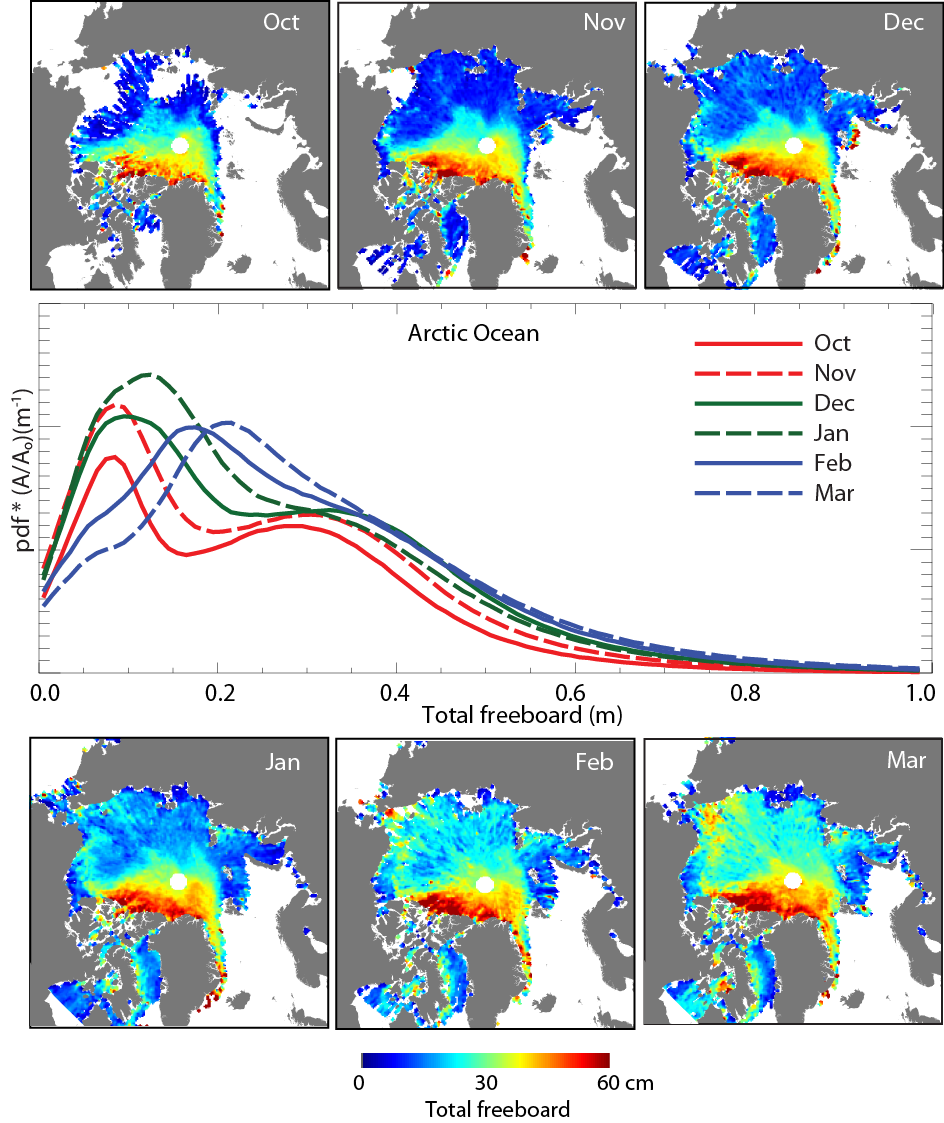
Figure 9 from [Kwok et al., 2019]
ATL21: Gridded Polar Sea Surface Height Data
Contains:
- 25 km gridded sea surface height anomalies for sea ice covered regions
Advantages:
- Gridded product that is lighter than ATL10
- Uses a sophisticated sea surface height retrieval algorithm to detect leads in polar oceans
Disadvantages:
- Coarse length scale, averages out the high resolution of the ICESat-2 data
- Only data from center strong beam available due to time and spatially varying biases
Use if you want to:
- Look at large-scale gridded sea surface height anomalies or derive dynamic ocean topography in polar regions
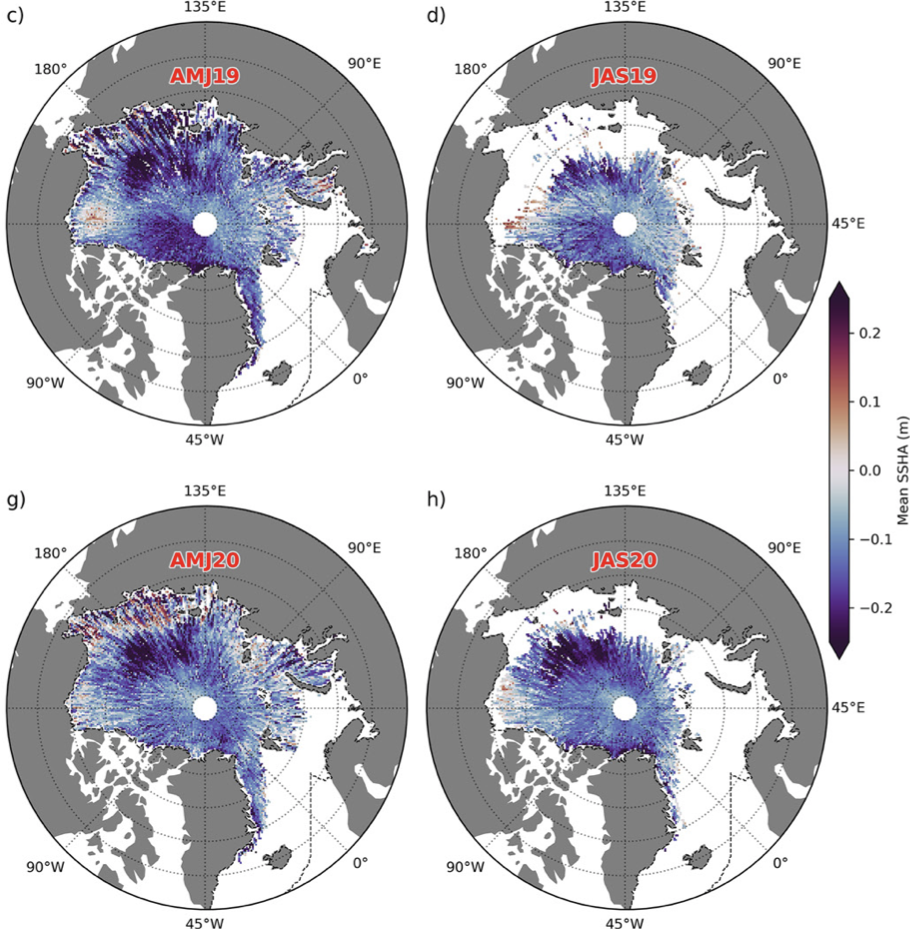
Figure 4 from [Bagnardi et al., 2021]
ATL08: Land and Vegetation Height Data
Contains:
- Terrain surface and canopy heights from land photons
Advantages:
- Can handle surfaces with multiple returns (such as vegetated canopies)
- Provides photon-level classifications from the ATL08 algorithm
Disadvantages:
- Can produce less reliable results over sloping surfaces
Use if you want to:
- Detect multiple surfaces, such as vegetated canopies or supraglacial lakes
- Look at vegetated terrain and need to detect the ground
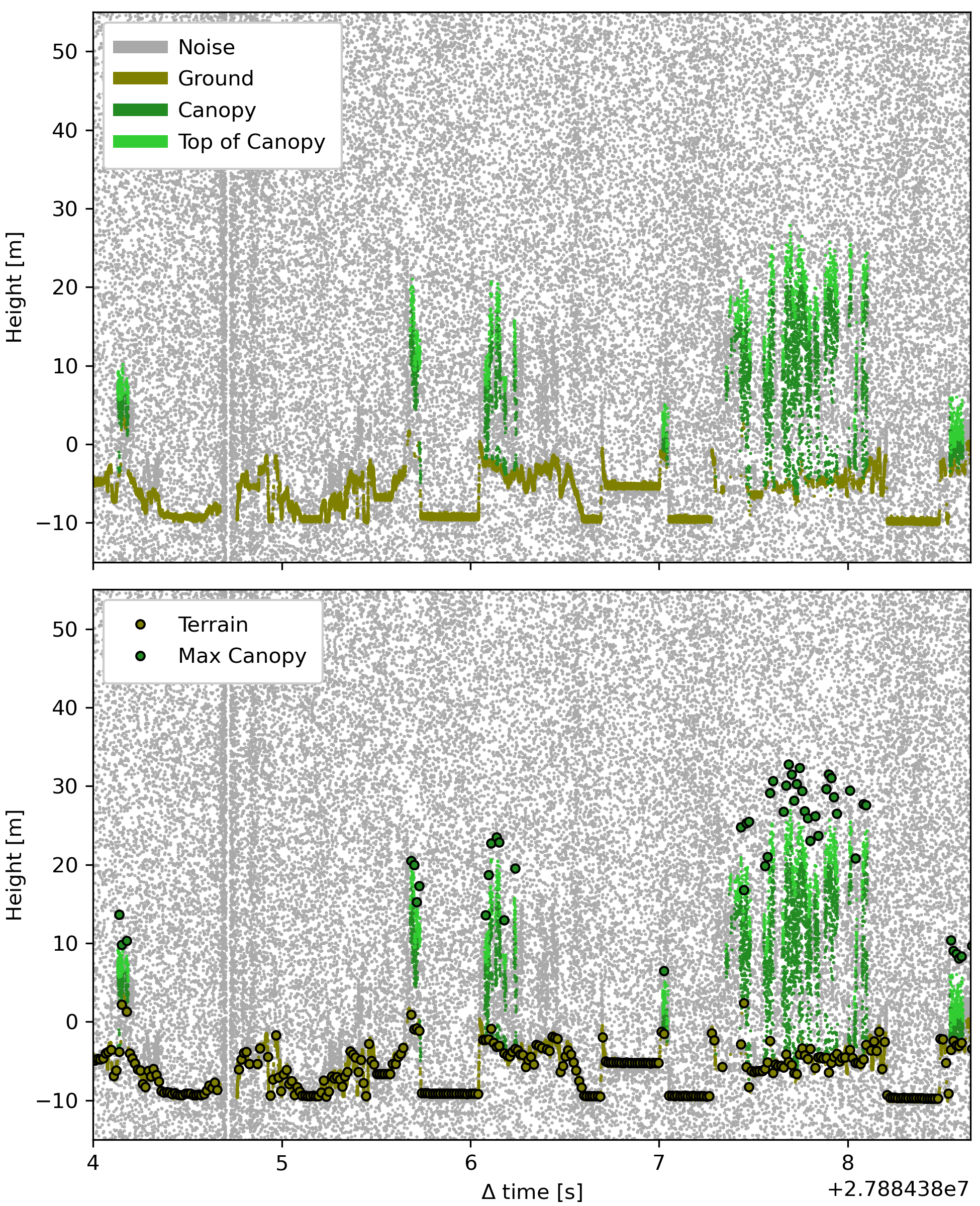
Figure recreated from Amy Neuenschwander (UT Austin)
ATL18: Gridded Land and Vegetation Height (in development)
Contains:
- Terrain and relative canopy heights at 1km resolution
Advantages:
- Uses EASE2.0 grids for compatibility with other datasets
- Will be updated annually
Disadvantages:
- Low spatial resolution limits creating a temporal change product
Use if you want to:
- Analyze large-scale vegetation and land surface change
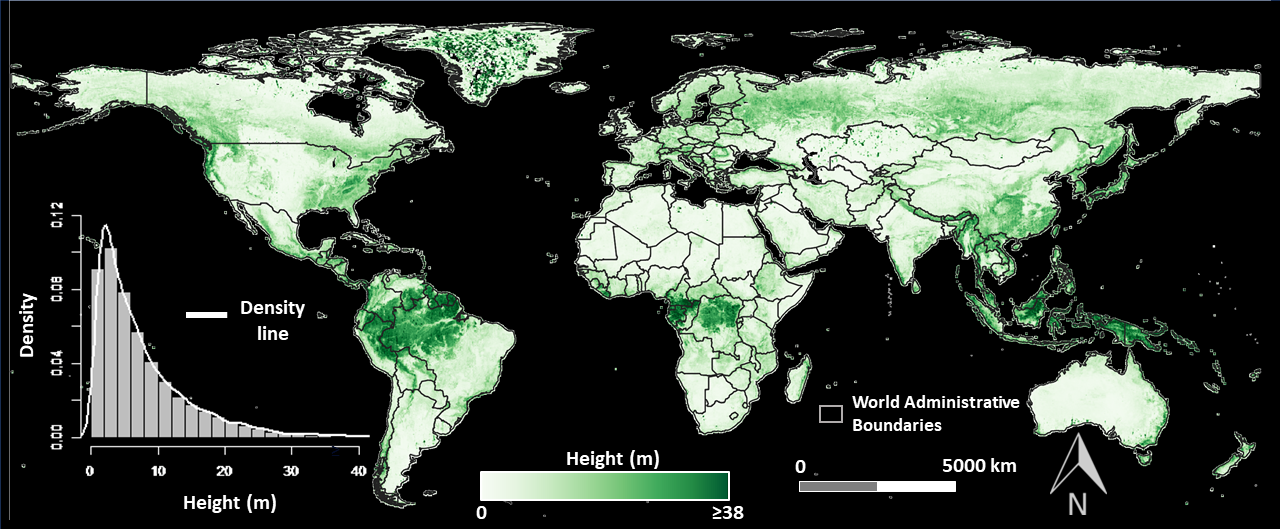
Figure from Amy Neuenschwander (UT Austin)
ATL12: Ocean Surface Height Data
Contains:
- Sea surface heights for oceans deeper than 10m
- Harmonic coefficients and statistics for waves
- Geophysical (e.g. sea state bias) corrections
Advantages:
- Average height estimates reduce the effects of correlated noise due to waves
- Also provides sea surface heights with cm-level corrections at spatial resolutions up to 10m
Disadvantages:
- Does not represent the sea surface in ice covered areas
Use if you want to:
- Detect the instantaneous sea surface height
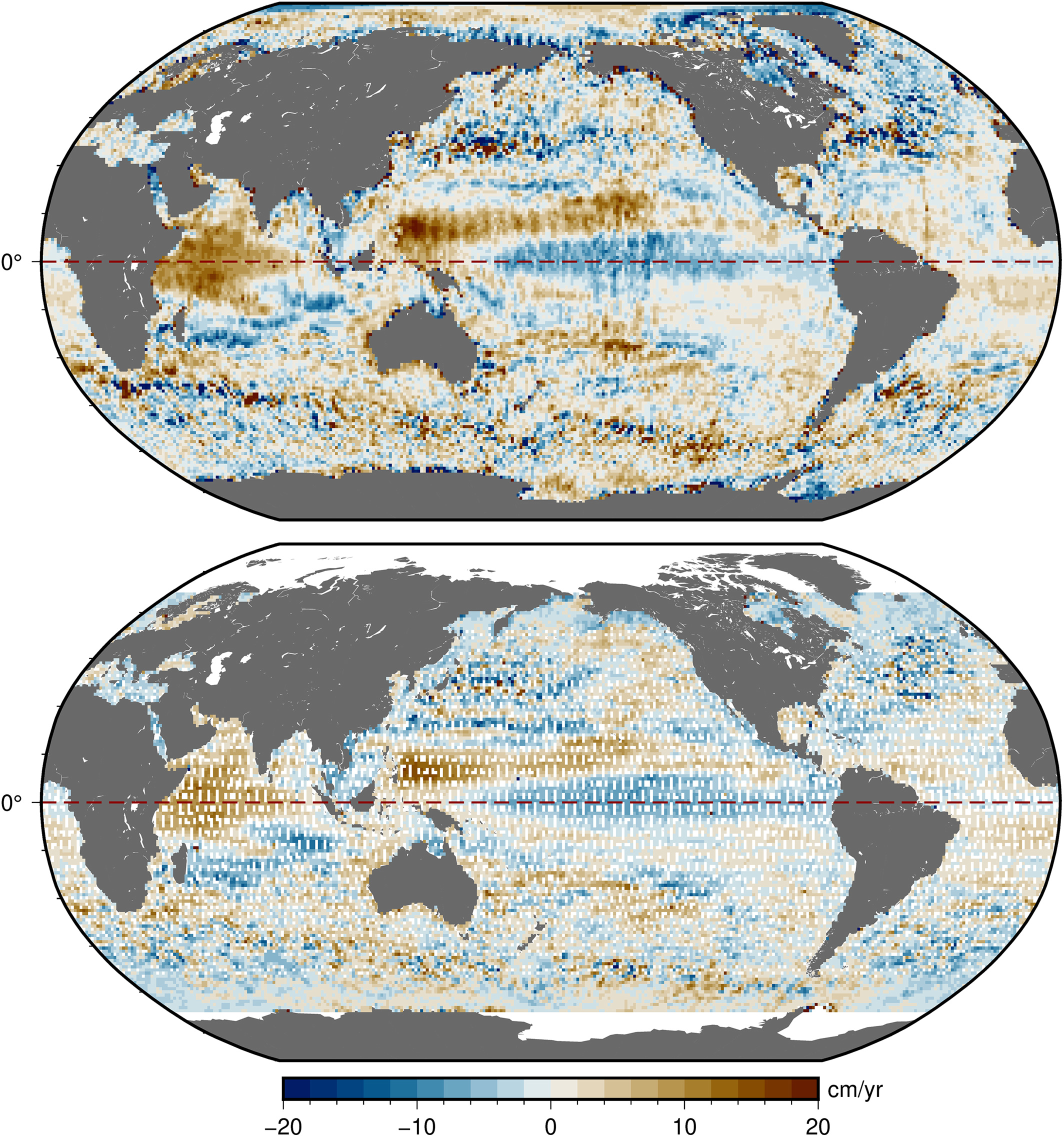
Comparison of ATL12 and JASON-3 from [Buzzanga et al., 2021]
ATL19 and ATL23: Gridded Dynamic Ocean Topography
Contains:
- Rasterized DOT at 1⁄4° (mid-latitudes) and 25 km (polar) spatial resolution
- Monthly (ATL19) and tri-monthly (ATL23) temporal resolution
Advantages:
- Lighter product than ATL12
- Includes individual beam averages
Disadvantages:
- Lower temporal resolution than ATL12
Use if you want to:
- Calculate the average DOT over time
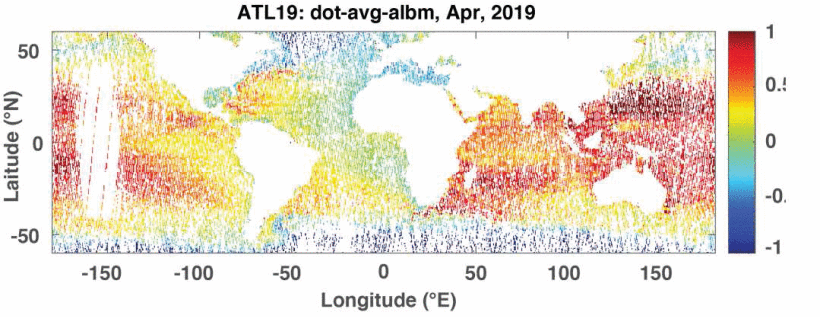
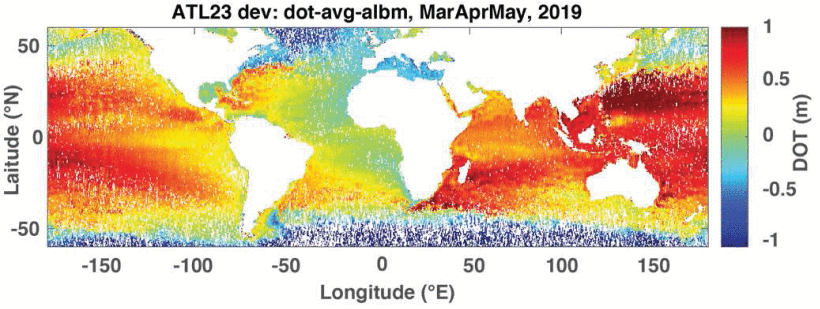
Figures 4 and 5 showing ATL19 and ATL23 from [Morison et al., 2022]
Product Information at the National Snow and Ice Data Center (NSIDC)
- The NSIDC DAAC is the primary data manager for ICESat-2 data
- On-prem data stores
- Cloud-based data stores (AWS s3)
- Mission landing page for ICESat-2 → https://nsidc.org/data/icesat-2
- Product landing pages (e.g. ATL03) → https://nsidc.org/data/atl03
- Each product landing page includes:
- User Guides
- Algorithm Theoretical Basis Documents (ATBDs)
- Data Dictionaries
- List of Known Issues
- Information for Data Access


Part 3
Mission Status and Future
2024 Safehold to Science Mode Timeline
- May 10: Massive solar storm (Largest since 1989!)
- May 10 – 17: Safehold
- May 14 – June 22: RGT excursion peaked at 286.526 km
- May 28 – June 18: Collected pure background
- June 18: Resumed RGT pointing on RGT 22
- June 21: Resumed Science Mode data collection on RGT 55
- June 22: Returned to nominal orbit
- June 25: Yaw flip to -X
- June 27: Resumed vegetation off-pointing and TOOs on RGT 145
- June 29: Completed on-orbit parameter optimization activities
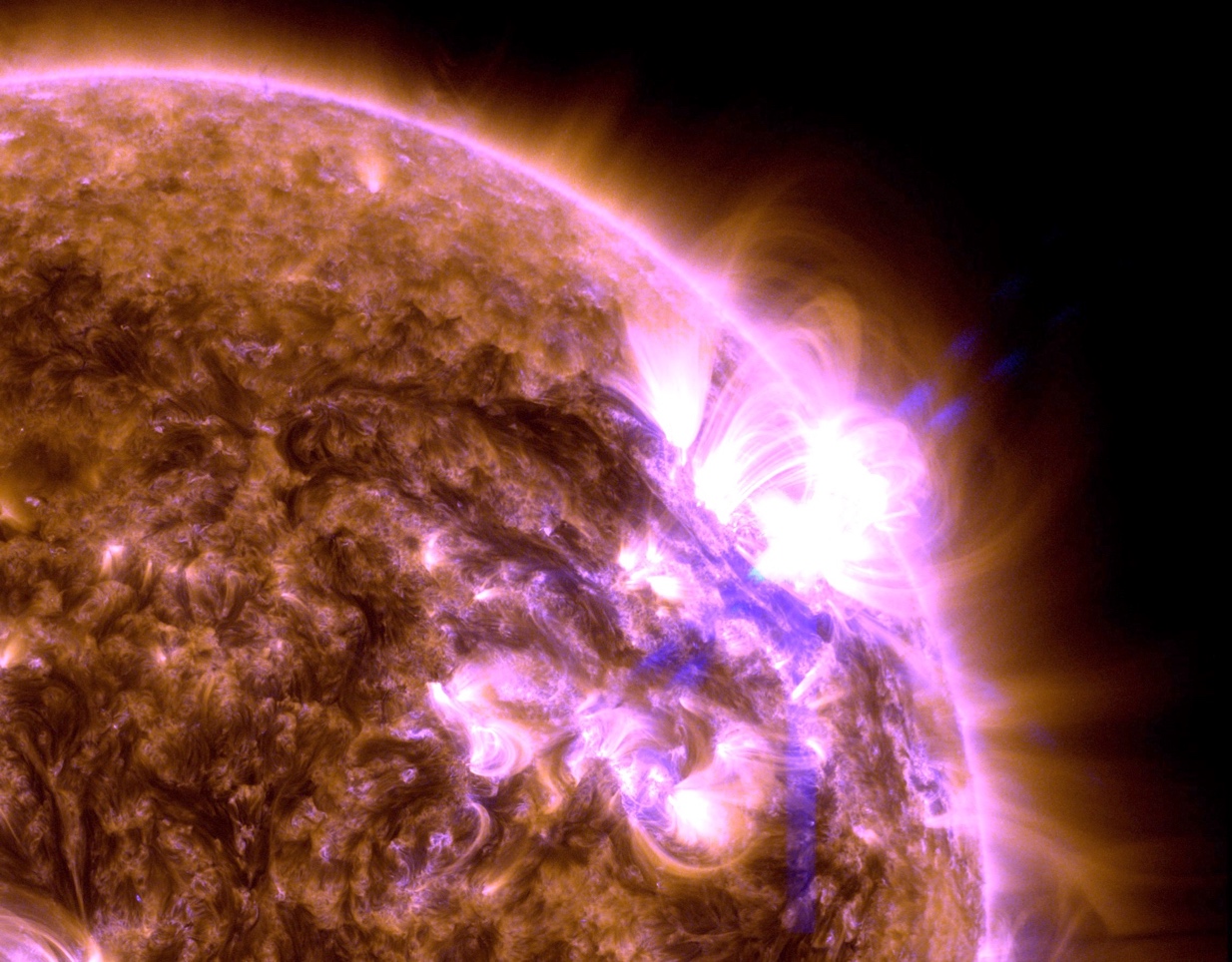
June 2024 ICESat-2 Project Science Office presentation
ICESat-2 Mission Status
Future Mission Outlook
- Current Status:
Nominal
- Performance metrics remain nominal and within mission requirements
- Over
2000
days in orbit - Over 1.8 trillion laser pulses and 15 trillion photons returned
- Life-limiting factor is on-board fuel → dependent on solar activity
Mission Product Development
- Target publication date of release 007 products: spring 2025
- Target publication date of ATL24 bathymetry product: late 2024 or early 2025
- Gridded Land and Vegetation Height product (ATL18) in development
- Gridded Sea Ice Freeboard Quicklook product (ATL20-QL) in development
- Possible future standard products are under development
August 2024 ICESat-2 Project Science Office presentation
Mission Lifetime Estimates
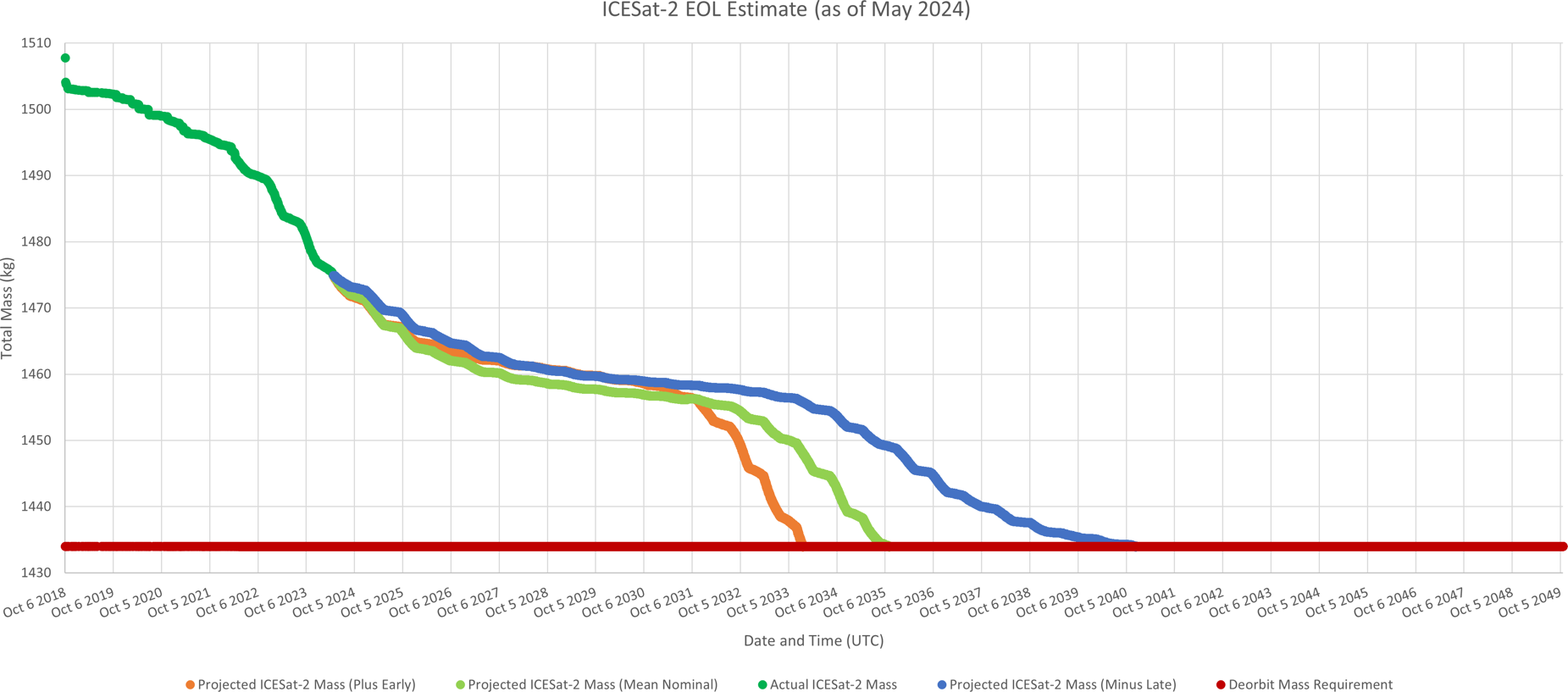
Current estimate for mean nominal End of Life: November 2035

